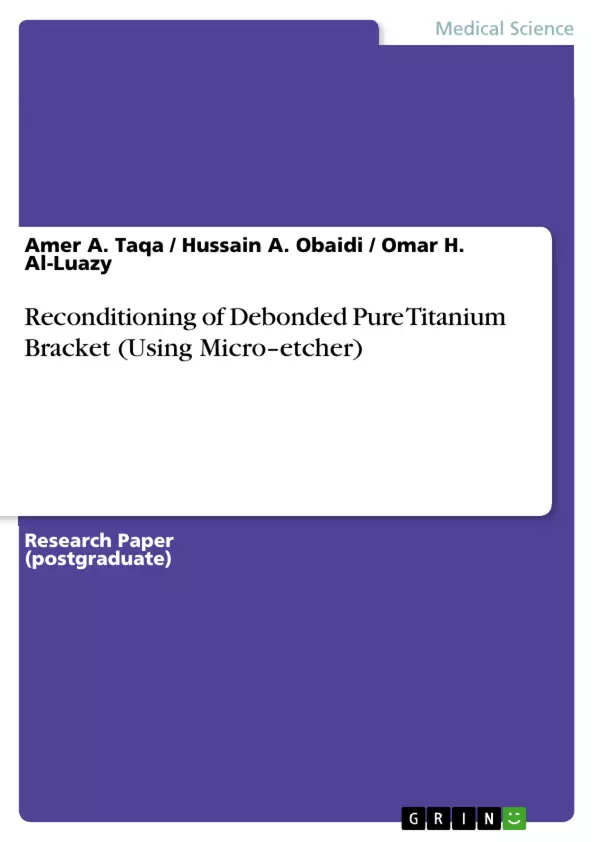Aims: To evaluate the degree of change that may occur in reconditioning the titanium bracket via micro-
etcher. Materials and Methods: The sample consisted of (10) pure titanium brackets for each of
control and reconditioning brackets. The parameters of the reconditioned bracket (slot width, slot
depth, inter–wing gap, labio–lingual angle and base curvature angle) were measured and compared
with that of the control bracket. Results: The results showed no significant difference between the control
and reconditioned brackets of the slot parameters (width, depth, inter–win gap, labio–lingual angle)
and the bracket’s base curvature angle. While, the tensile bond strength of the control brackets
showed significantly higher mean value as compared with the recycled group. Conclusions: The reconditioning
of pure titanium brackets is recommended for reuse in the orthodontic treatment after sterilization
Inhaltsverzeichnis (Table of Contents)
- ABSTRACT
- INTRODUCTION
- MATERIALS AND METHODS
- RESULTS
- DISCUSSION
- CONCLUSIONS
- REFERENCES
Zielsetzung und Themenschwerpunkte (Objectives and Key Themes)
This study aims to evaluate the effectiveness of reconditioning titanium orthodontic brackets using a micro-etcher. The research focuses on the degree of changes that may occur in the bracket's slot dimensions and base curvature angle after the reconditioning process.
- The effects of micro-etching on bracket slot dimensions (width, depth, inter-wing gap, labio-lingual inclination angle)
- The impact of reconditioning on the bracket base curvature angle
- Comparison of tensile bond strength between control and reconditioned brackets
- Evaluation of the feasibility and recommendation for reusing reconditioned brackets in orthodontic treatment
- Analysis of the micro-etching method's impact on bracket retention and bond strength
Zusammenfassung der Kapitel (Chapter Summaries)
The study's introduction provides background information on the use of titanium brackets in orthodontics and the potential benefits of recycling them. The authors highlight existing research on micro-etching techniques for reconditioning brackets and their effects on bond strength.
The Materials and Methods section details the methodology employed, including the selection of bracket samples, teeth, and bonding materials. The research protocol outlines the steps involved in the reconditioning process, measurement techniques for evaluating bracket dimensions, and the tensile bond strength testing procedure.
The Results section presents the descriptive statistics of the data, including mean values, standard deviations, minimum and maximum values for various parameters. It analyzes the differences between control and reconditioned brackets, focusing on slot dimensions, base curvature angle, and tensile bond strength.
The Discussion section provides an interpretation of the study's findings, highlighting the insignificant effect of micro-etching on slot dimensions and base curvature angle while demonstrating a significant reduction in tensile bond strength of reconditioned brackets. It connects the findings to existing literature and explores potential explanations for the observed results.
Schlüsselwörter (Keywords)
The study focuses on the key concepts of titanium bracket reconditioning, micro-etching, bond strength, slot dimensions, and base curvature angle. It explores the potential of recycling orthodontic brackets for reuse in treatment and analyzes the impact of the reconditioning process on bracket retention and bond strength.
- Quote paper
- Dr. Amer A. Taqa (Author), Hussain A. Obaidi (Author), Omar H. Al-Luazy (Author), 2008, Reconditioning of Debonded Pure Titanium Bracket (Using Micro–etcher), Munich, GRIN Verlag, https://www.grin.com/document/207701



